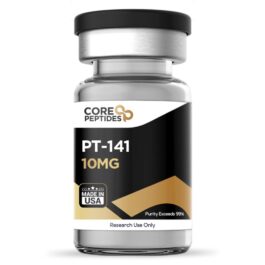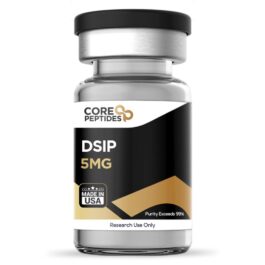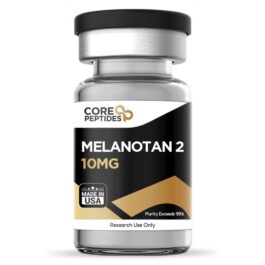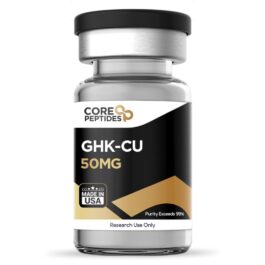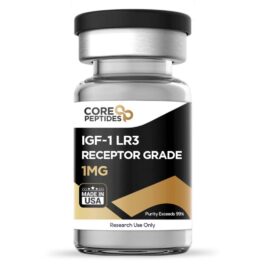MGF (5mg)
$50.00
Size: 5mg
Contents: MGF (5mg)
Form: Lyophilized powder
Purity: >99%
SKU: P-MGF-5
FREE Shipping on $200+ orders
Discount per Quantity
| Quantity | Discount | Price |
|---|---|---|
| 5 - 8 | 5% | $47.50 |
| 9 + | 10% | $45.00 |
Mechano Growth Factor (MGF) Peptide
MGF stands for Mechano Growth Factor, an endogenous, naturally occurring peptide that belongs to the class of IGF-1 (insulin-like growth factor) family.(1) What differentiates MGF from systemic IGF-1 is that it contains 49 base pairs at exon 5 in its structural composition, which may possibly introduce a frameshift to exert unique characteristics.(2) Researchers consider MGF to be an isoform of IGF-1, also known as IGF-1Ec (otherwise referred to as full-length MGF).(3)
As IGF-1 undergoes alternative splicing and transcription, it appears to produce three isoforms. IGF-1 undergoes splicing under stress conditions, such as during resistance activities within muscle groups.(4) As a result of this splicing and due to the unique 49 base pair insert added to the peptide, it may produce a mature isoform of IGF-1, namely, naturally occurring MGF.(4)
Overview
During IGF-1 research studies, scientists first posited the phenomenon of IGF-1 splicing and isoform production. The only factor identified by the researchers that distinguished the three isoforms appears to be the amino acid sequence attached to the COOH terminal. It was only in the late 1990s and early 2000s that the uniqueness of IGF-1Ec was suggested when it was theorized that its levels increased upon muscle injury.(5)
There is a synthetic version of the MGF peptide composed of 24 amino acids attached to the C-terminal of the isolated MGF domain, called MGF-Ct24E peptide, or E-domain of IGF-1Ec.(6) During the studies conducted in the early 2000s,(6) it was suggested that the MGF-Ct24E peptide may exhibit potential to induce muscle precursor cell proliferation. Muscle precursor cells are ‘satellite’ cells in myofiber, which increase to form new muscles.
MGF is posited to increase in a growth hormone-dependent fashion, akin to IGF-1, which is also considered to potentially represent the main anabolic mediator of growth hormone. Studies suggest that growth hormones may also impact MGF expression by approximately 80%, relative to the baseline. In stark contrast, resistance activity in muscle tissue alone appears to elicit a response in MGF mRNA, with an increase of 163% from baseline. This immediate response may suggest a more direct or sensitive reaction of MGF to mechanical stimuli, yet the extent and nature of this sensitivity remain speculative. An apparent elevation of growth hormone that occurs in addition to resistance training might further complicate this response, as supported by a reported 456% increase in MGF mRNA.(7)
Research studies are still underway to determine the mechanism of action of both the naturally occurring and synthetically developed MGF peptide. Hypotheses under investigation include the peptide's potential impact on damaged muscle cells, tissue repair and recovery, possible neuroprotective and cardioprotective characteristics, and potential impact on muscle cell apoptosis.
Chemical Makeup
Molecular Formula: C124H204N42O41S1
Molecular Weight: 2971.99 g/mol
Other Known Titles: MGF-E, MGF-Ct24E
Research and Clinical Studies
MGF Peptide and Muscle Mass
The main aim of one critical study on MGF(8) was to determine the potential of the synthetic peptide, aka the MGF-E domain made of 24 amino acids, on different aged cells. This was a study where muscle cell cultures, which ranged from neonatal to aged, were evaluated. The culture cells were analyzed after exposure to MGF-E. The peptide seemed to delay the onset of cellular senescence in younger cells, suggesting a potential to preserve muscle function and repair capabilities that diminish naturally. Furthermore, the results suggested cell proliferation in all cells isolated from neonatal to young cells; however, this was not the case in aged cells. Muscle hypertrophy appeared to be increased in the older cells, with a significant decrease in the reserve cells. It appeared to have induced hypertrophy in muscle cells across all ages by increasing the fusion index and the size of myotubes, which are formed from the fusion of muscle cells. The researchers observed that MGF-E may potentially also increase the expression of muscle-specific contractile proteins, indicating not only an increase in muscle cell size but also in functional capacity. Furthermore, the reduction in reserve cells appears notable as this may be a subpopulation of cells that do not initially differentiate or fuse into myotubes. MGF-E apparently led to a decreased proportion of these reserve cells in culture, suggesting that the peptide might prompt these cells to contribute to muscle formation. This finding is particularly noteworthy as it points to a mechanism by which MGF might potentially enhance muscle regeneration and maintenance.
MGF Peptide and Muscle Recovery
The main aim of another study(9) was to evaluate the potential of MGF on skeletal muscle injury repair and healing. This study was performed on mice that were experimentally induced with muscle contusion. Following Mechano Growth Factor (MGF) exposure and analysis of the muscle tissues, researchers suggested that MGF may have reduced the expressions of inflammatory markers such as cytokines and chemokines. Further, there was an apparent reduction of oxidative stress markers and matrix metalloproteinases (MMPs), suggesting that MGF might mitigate some inflammatory and fibrotic responses in muscle injury. As a result, the rate of contused muscles appeared to decline, which might induce long-term muscular repair of the wounded tissues. Moreover, the study hints that MGF may potentially not markedly impact the functional state of satellite cells following injury and immune cell depletion at the injury site, which is integral to muscle regeneration. This inference is drawn from observing unaltered expression levels of MyoD and myogenin—key satellite cell proliferation and differentiation indicators, respectively. This suggests that while MGF might potentially ease certain aspects of the muscle injury response, its direct action on satellite cell activity under the explored conditions remains uncertain. Subsequent examinations suggest that MGF exposure might influence fibrosis in injured muscle by possibly reducing the expression of collagen types I and III, crucial for the extracellular matrix and fibrotic development. The study further hints that MGF may play a part in adjusting the inflammatory setting within injured muscles. This is somewhat illustrated by a purported reduction in the expression of pro-inflammatory cytokines (TNF-α, IFN-γ, IL-1β, TGF-β) and chemokines (CCL2, CCL5, CXCR4) post-MGF exposure. Moreover, there's a speculative suggestion that MGF might assist in alleviating oxidative stress in injured muscle, indicated by a possible decrease in the expression of gp91phox, a vital component of NADPH oxidase implicated in the production of reactive oxygen species.
MGF Peptide and Anti-Apoptotic Potential
The main goal of this study(10) was to evaluate the potential of MGF on cardiac muscles undergoing programmed cell death (apoptosis) following hypoxia, a condition characterized by limited supply of oxygen. The study reported that the peptide appeared to induce increased migration of stem cells to the heart tissues exposed to hypoxia, which possibly led to inhibition of apoptosis. This suggests that MGF may play a dual role in cardiac function, acting as a potential anti-apoptotic compound and a stem cell-homing factor. The researchers highlight that MGF potentially enhances the migration of mesenchymal stem cells (hMSCs), indicating a chemotactic action that might be leveraged to direct stem cells toward regions of damage or injury. Moreover, in an environment simulating hypoxic stress—a condition akin to that experienced by heart tissue during ischemic events—MGF is suggested to exhibit protective potential in cardiac cells. This hypothesis was raised by observation of increases in the expression of Bcl-2, a gene associated with cell survival, underscoring MGF's potential anti-apoptotic action.
MGF Peptide and Skeletal Injury
The main goal of this study(11) was to evaluate the potential of MGF on bone injury. A total of 27 rabbits were experimentally induced with a 5-mm bone defect and were then divided into three groups that were presented with MGF or with a control substance for 5 consecutive days. Post-study, the researchers reported that the placebo tissue appeared to be the least healed when the bone tissues were histologically examined. In contrast, the bone tissue with MGF appeared to be the most healed tissue. Regarding the potential impact on osteoblast-like cell proliferation, the investigation hints that MGF might potentially enhance proliferation. This enhancement appears to be more pronounced when compared with IGF-1, leading to the speculation that MGF may activate cellular mechanisms somewhat differently from IGF-1. The study points out that MGF might play a role in arresting the cell cycle in certain phases and could be involved in activating the MAPK-Erk1/2 signaling pathway. Such actions imply that MGF may have a complex approach to promoting cell proliferation, perhaps through a blend of influencing cell cycle dynamics and engaging specific signaling pathways. Moreover, the study ventured into assessing the possible actions of MGF utilizing a rabbit model with established bone defects. Here, MGF was introduced, and its influence on bone healing was monitored via radiographic and histological evaluations. The findings tentatively indicate that bone healing might be improved in defects exposed to MGF, as suggested by seemingly better rates of radiographically healed defects and improved histological scores for bone healing.
MGF Peptide and Brain Ischemia
The main purpose of a 2005 study(12) was to combat ischemic stroke through the potential action of MGF peptides. The actions were studied in experiments conducted on gerbil research models of brain ischemia. The synthetic Mechano Growth Factor peptide was presented as an ischemic mitigator. Researchers reported that MGF appeared to lead to increased protection of brain cells. Interestingly, in the same model, it was also reported that ischemia appeared to lead to elevated endogenous MGF production in the ischemia-resistant neurons. Additional studies were carried out in degenerated hippocampal cell culture, to which MGF was added. MGF exhibited reportedly similar results of muscle proliferation. This potential action is believed to be due to the C-terminal of the MGF peptide, which may exert some level of neuroprotective action.
MGF Peptide and Brain Cells
A notable study (13) was conducted on a murine model to study the action of increased MGF concentration on brain cells. One study included breeding mice to constitutively overproduce MGF in the hippocampus area of the brain. The hippocampus is primarily responsible for regulating the neurogenesis phenomenon in the organism. This overproduction of MGF appeared to result in high concentrations of BrdU, a biological marker representative of proliferative actions in the organism. More specifically, the mice were bred for conditional MGF production at 1, 3, and 12 months old. Behavioral analysis and biological responses were examined after 2 years. These mice were reported to exhibit elevated levels of BrdU and neurogenesis.
MGF peptide is available for research and laboratory purposes only. Please review and adhere to our Terms and Conditions before ordering.
References:
- Philippou A, Papageorgiou E, Bogdanis G, Halapas A, Sourla A, Maridaki M, Pissimissis N, Koutsilieris M. Expression of IGF-1 isoforms after exercise-induced muscle damage in humans: characterization of the MGF E peptide actions in vitro. In Vivo. 2009 Jul-Aug;23(4):567-75. https://pubmed.ncbi.nlm.nih.gov/19567392/
- Goldspink G. Impairment of IGF-I gene splicing and MGF expression associated with muscle wasting. Int J Biochem Cell Biol. 2006 Mar;38(3):481-9. https://pubmed.ncbi.nlm.nih.gov/16463438/
- Zabłocka, B., Goldspink, P. H., Goldspink, G., & Górecki, D. C. (2012). Mechano-Growth Factor: an important cog or a loose screw in the repair machinery? Frontiers in endocrinology, 3, 131. https://www.ncbi.nlm.nih.gov/pmc/articles/PMC3485521/
- G Goldspink. Research on mechano growth factor: its potential for optimising physical training as well as misuse in doping. Department of Surgery, Royal Free and University College Medical School, Hampstead Campus, Rowland Hill Street, London NW3 2PF. https://bjsm.bmj.com/content/39/11/787
- Rotwein P. (2014). Editorial: the fall of mechanogrowth factor?. Molecular endocrinology (Baltimore, Md.), 28(2), 155–156. https://www.ncbi.nlm.nih.gov/pmc/articles/PMC3896639/
- Mills P, Dominique JC, Lafrenière JF, Bouchentouf M, Tremblay JP. A synthetic mechano growth factor E Peptide enhances myogenic precursor cell transplantation success. Am J Transplant. 2007 Oct;7(10):2247-59. https://pubmed.ncbi.nlm.nih.gov/17845560/
- Hameed M, Lange KH, Andersen JL, Schjerling P, Kjaer M, Harridge SD, Goldspink G. The effect of recombinant human growth hormone and resistance training on IGF-I mRNA expression in the muscles of elderly men. J Physiol. 2004 Feb 15;555(Pt 1):231-40. doi: 10.1113/jphysiol.2003.051722. Epub 2003 Oct 17. PMID: 14565994; PMCID: PMC1664832.
- Kandalla PK, Goldspink G, Butler-Browne G, Mouly V. Mechano Growth Factor E peptide (MGF-E), derived from an isoform of IGF-1, activates human muscle progenitor cells and induces an increase in their fusion potential at different ages. Mech Ageing Dev. 2011 Apr. https://pubmed.ncbi.nlm.nih.gov/21354439/
- Liu X, Zeng Z, Zhao L, Chen P, Xiao W. Impaired Skeletal Muscle Regeneration Induced by Macrophage Depletion Could Be Partly Ameliorated by MGF Injection. Front Physiol. 2019 May 17;10:601. https://pubmed.ncbi.nlm.nih.gov/31164836/
- Doroudian, G., Pinney, J., Ayala, P., Los, T., Desai, T. A., & Russell, B. (2014). Sustained delivery of MGF peptide from microrods attracts stem cells and reduces apoptosis of myocytes. Biomedical microdevices, 16(5), 705–715. https://doi.org/10.1007/s10544-014-9875-z
- Deng M, Zhang B, Wang K, Liu F, Xiao H, Zhao J, Liu P, Li Y, Lin F, Wang Y. Mechano growth factor E peptide promotes osteoblasts proliferation and bone-defect healing in rabbits. Int Orthop. 2011 Jul;35(7):1099-106. https://pubmed.ncbi.nlm.nih.gov/21057789/
- Dluzniewska J, Sarnowska A, Beresewicz M, Johnson I, Srai SK, Ramesh B, Goldspink G, Górecki DC, Zabłocka B. A strong neuroprotective effect of the autonomous C-terminal peptide of IGF-1 Ec (MGF) in brain ischemia. FASEB J. 2005 Nov;19(13):1896-8. https://pubmed.ncbi.nlm.nih.gov/16144956/
- Tang JJ, Podratz JL, Lange M, Scrable HJ, Jang MH, Windebank AJ. Mechano growth factor, a splice variant of IGF-1, promotes neurogenesis in the aging mouse brain. Mol Brain. 2017 Jul 7;10(1):23. doi: 10.1186/s13041-017-0304-0. PMID: 28683812; PMCID: PMC5501366.


